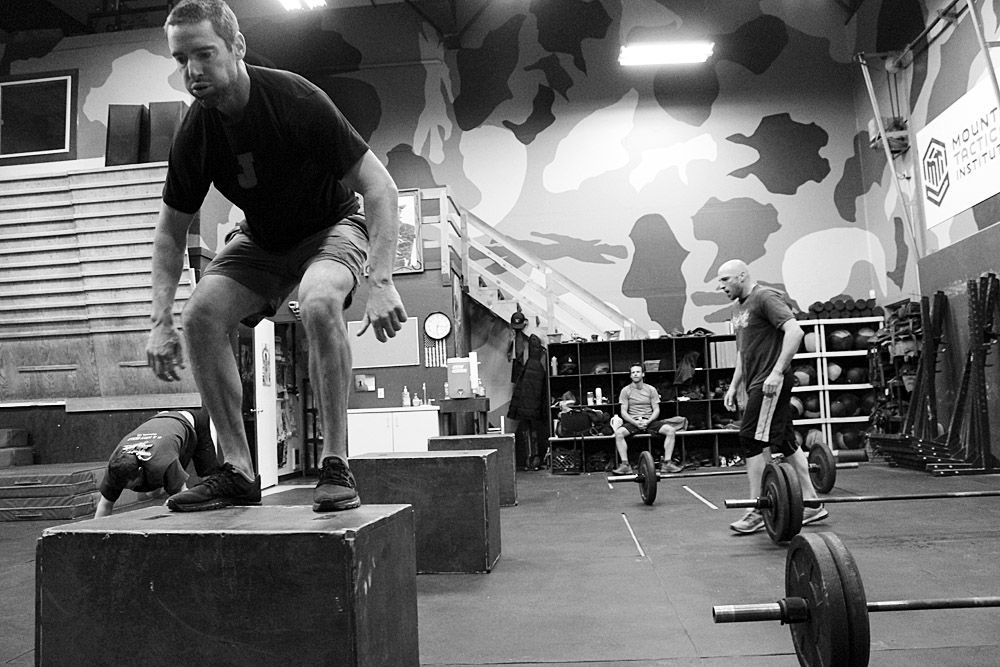
By Rob Shaul, Founder
BLUF
We conducted a mini study comparing the work capacity improvement of shuttle sprint repeats vs short, multi-modal HITT efforts, but the results were inconclusive
Background
Crossfit popularized short, multi-modal HIIT (High Intensity Interval Training) in the mid-1990s and impact continues. While Crossfit Founder Greg Glassman did not invent multi-modal work capacity, he and Crossfit certainly took it to another level.
However, shuttle sprint repeats have been used to train work capacity for decades – and many of us can remember running “gassers” in middle school football practice or suicide sprints in middle school basketball practice.
Shuttle sprint work capacity programming has several advantages over multi-modal HIIT efforts including:
- no need for any equipment
- can be completed outside, inside, or anywhere
- more “mission direct” for both mountain and tactical athletes. Especially tactical athletes and “movement under fire” fitness
Further, this meta-analysis found several advantages of sprint intervals over HIIT training:
- SIT resulted in a 39.59% higher reduction in body fat percentage than HIIT.
- SIT significantly outperformed HIIT in Body Fat Percentage (BF%) reduction while requiring 60.84% less time spent exercising than HIIT.
- SIT participants spent 81.46% less time sprinting in comparison to time spent doing high-intensity intervals of HIIT.
- On average, SIT conducted 10% fewer workouts per week and these workouts were 44% shorter in comparison to HIIT.
- During these workouts, the SIT group did 4.68% fewer sprints than the HIIT participants did their high-intensity intervals.
- These sprints were 85.64% shorter in duration than the high-intensity intervals of the HIIT group
With this mini study we wanted to do our own test of sprint intervals vs. HIIT training for work capacity results.
Study Design/Deployment
A small, quick mini-study is a great tool for us to accomplish several things before conducting a larger, longer, more involved study. First, we test the practicality and “churn” the testing protocols in the study. Second, mini study results can help us quickly identify obvious paths to follow with further research. Mini Studies are the primary tool we deploy for MTI’s Mission Direct Research.
The “mission-direct” emphasis of MTI’s research significantly impacts study design. Ideally, our mini-studies deploy elements that are practical and commonly used/experienced by our mountain and tactical athlete population. As well, ideally, our mini studies are simple enough that the same study can be completed by others, without special equipment, techniques, or expertise.
This study utilized veteral, remote, MTI lab rats who were split into two groups: Sprint Group and HIIT Group.
The Day 1 of the 3 week, 5 day/week cycle, each group completed the same two assessments:
(1) 3 Rounds for Time
- 5x Power Clean @ 65/95#
- 5x Burpees
- 5x Box Jump @ 20″
(2) 300m Shuttle for Time
During the following 3 weeks of programming, the Sprint Group did only Sprint Intervals for work capacity training and the HIIT Group did only multi-modal HIIT for work capacity training.
This was the weekly schedule for the Sprint Group:
- Monday: Strength (same for both groups), Work Capacity – Sprint Intervals
- Tuesday: Chasss Integrity (same for both groups) Work Capacity – Sprint Intervals
- Wednesday: Easy Pace Unloaded Run (same for both groups)
- Thursday: Strength (same for both groups), Work Capacity – Sprint Intervals
- Friday: Chasss Integrity (same for both groups) Work Capacity – Sprint Intervals
This was the weekly schedule for the HIIT Group:
- Monday: Strength (same for both groups), Work Capacity – HIIT
- Tuesday: Chasss Integrity (same for both groups) Work Capacity – HIIT
- Wednesday: Easy Pace Unloaded Run (same for both groups)
- Thursday: Strength (same for both groups), Work Capacity – HIIT
- Friday: Chasss Integrity (same for both groups) Work Capacity – HIIT
At the end of 3 weeks, both groups re-took the two inital assessments, and improvement results over the course of the cycle were compared.
Results/Discussion
The results are below.

Both Groups improved in both assessments, which makes sense. However, I expected the Sprint Group to have a greater improvement in the Sprint re-assessment and the HIIT Group to have a greater improvement in the HIIT re-assessment. But this didn’t happen.
Both groups had nearly the same average improvement for the 300m Shuttle for Time, and the Sprint Group’s improvement in the HIIT assessment was significantly greater than the HIIT Group’s average improvement.
I can’t explain these results.
As well, nothing in these results indicate an advantage for one work capacity training mode over the other (Sprint Interval vs HIIT).
This leads me to believe there is some significant flow in the research study design, but I can’t readily identify it.
The findings from the meta analysis above primarily looked at body fat loss, and not performance improvement when comparing Sprint Interval training to HIIT. This study didn’t look at this metric.
Next Steps?
In general, simple training is better than more complex training, and in terms of simplicity, sprint intervals are more simple than HIIT training. However, performance improvement is the most important metric for MTI, and this study was inconclusive at best, and confounding at worst, when it comes to performance improvmment in comparing these two modes.
Next Step? Perhaps deep dive into Sprint Intervals and HIIT and do mini studies within each training mode. For example, compare Short distance Sprint Interval efforts to longer sprint interval efforts. Say compare the work capacity improvement of 300m shuttle sprints (25m lengths) to 400m repeats (400m continuous).
Likewise, deep dive into HIIT and look at the exercise selection for these efforts including loading and level changes.
Perhaps look at the work capacity improvment of a HIT effort that includes shuttle sprints, for example, 3 Rounds for Time of 5x Power Clean + 4x 25m Shuttles.
As you can see, there is lots to consider.
Questions, Feedback, Comments? Email coach@mtntactical.com
You Might Also Like MTI’s Rucking Improvement Plan
